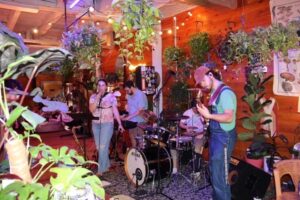Hello from Paphos, Cyprus! I’m writing this from my hostel while nursing a sunburn from many hours spent on the beach today. I’m here from April 10-17, and I’m hoping to soak up as much of the Mediterranean sun as possible.
A bit on Paphos before I dive into the reason I’m here — Paphos is a city (though a small one) in Cyprus, an island in the middle of the Mediterranean Sea located just to the west of Israel, about an hour away by plane. The island is full of ancient ruins, gorgeous beaches and plenty of nature to fill up every day of my visit. It also is the birthplace of the Greek goddess Aphrodite, and interestingly enough, half of the Island is Greek, while the other half is Turkish, though Cyprus itself is its own country. It’s a bit of a confusing concept at first.
So far, I’ve visited Aphrodite’s bath, hiked the Aphrodite trail through the coastal mountains in western Paphos and spent some time walking along the rocky coast of Coral Bay, which forms beautiful natural pools from the ocean and smooth, white rocks from thousands of years of being beat down by water. On Sunday, I’m renting a car and heading east to Limassol, a city just over a mile away. The only obstacle (aside from having no phone service and having to rely on real, old-fashioned, paper maps) is that they drive on the opposite side of the road here — hopefully I remember that while I’m behind the wheel.
The reason I’m in Cyprus is because we have a large chunk of time off from school for Passover break. Passover is a Jewish holiday — one of the major ones no matter where you are in the world — and is my personal favorite. The background story of Passover surrounds the Jewish people escaping from Egypt long ago, before they inhabited Israel.
The typical Passover traditions include a Seder, which is a meal that takes place on the first night of Passover in Israel, while in America there’s a Seder on both the first and second nights. During the Seder, the story of Passover is retold throughout the course of the evening, and each part of the story has different actions that go with it – many of them being eating different kinds of foods that are representative of parts of the story. For example, we eat bitter herbs (typically horseradish) as a symbol of the bitterness of the Jews’ enslavement in Egypt. Seders are usually attended by a large group of people, often extended family and friends. The evening usually last for a few hours, as the Seder not only includes the story of Passover, but also a break for dinner, the continuation of the story after dinner and other activities such as finding the “Afikomen,” which is a piece of matzah that’s hidden somewhere in the room for one of the young attendees to find after dinner. This is typically a very popular part of the Seder among the younger kids – when I was that age, it was really the only part I paid much attention to, if we’re being honest.
Now that I mentioned matzah, I should explain what exactly that is, because it’s a huge part of observing Passover. Possibly the most well-known tradition of Passover is that for eight days and eight nights (the duration of the holiday), you can’t eat anything that has been leavened, any sort of bread or yeast-containing food that has been allowed the time to rise. This is because when the Jews escaped Egypt, they didn’t have time for their bread to rise or else they might not make it out, so they rushed off with the unleavened bread that we now call matzah.
Israel takes the typical Passover traditions up a few notches. For example, prior to Passover, a ritual takes place in which Jews remove all leavened food products from their home and thoroughly clean the entire home to remove any traces of these foods. Yet in Israel, this doesn’t only occur in homes; many hotels partake in this tradition as well, and therefore the prices rise for the hotels during this time to cover the effort they had to make to do so. Additionally, many restaurants in Israel observe Passover by creating a special kosher menu, offering matzah dishes and potato bread as a substitute for anything leavened. The grocery stores, too, clean the entire store prior to Passover, just as people do in their homes, and during Passover, sheets are placed over all items in the store that are not kosher for Passover. Apparently it’s not completely forbidden to sell the items during Passover, but it’s not exactly socially accepted to buy them, either.
Passover has always been my favorite Jewish holiday. Year after year, it’s a fun challenge to see if I can remember not to eat anything leavened for a week, and it’s a nice change from what I’m used to. It certainly helps that matzah tastes delicious with almost anything on it, from butter and jam, to chocolate-covered matzah and matzah pizza. But considering how much I love Passover at home, I am absolutely ecstatic to have the opportunity to experience the holiday in Israel, where the story of Passover technically ends (as the Jews arrive after their escape) and the entire country embraces the traditions. I can’t wait to watch the country adapt to the holiday, and although our Passover break from school actually lasts until April 29, I was sure to schedule my trip to Cyprus in time to get me back for the Passover Seder on the first night, so I could spend the entire holiday in Israel and see it all for myself.






